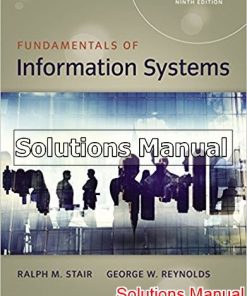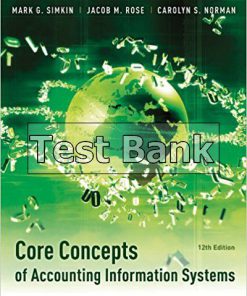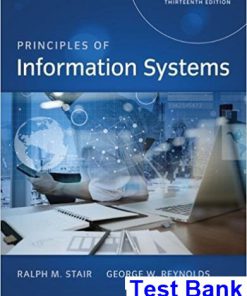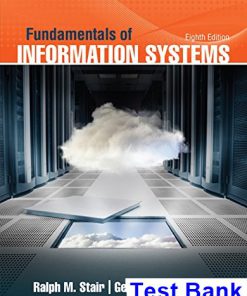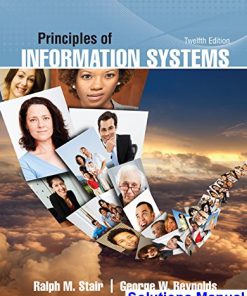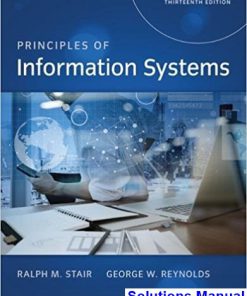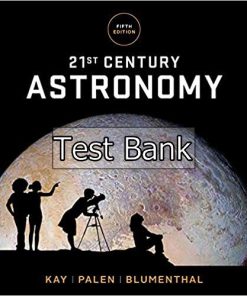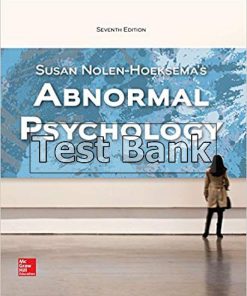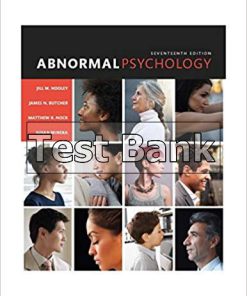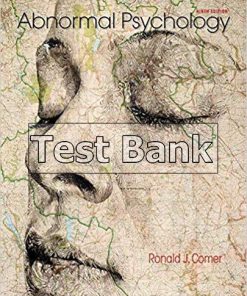Principles of Information Systems 12th Edition Stair Test Bank
You may also like
Principles of Information Systems 12th Edition Stair Test Bank
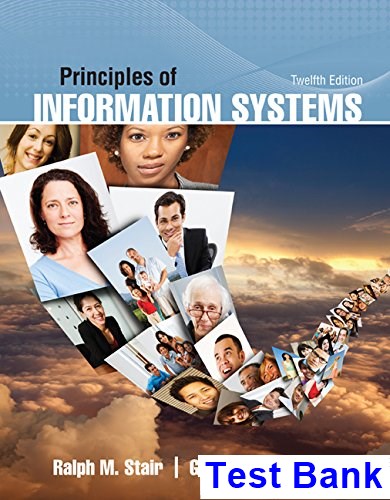
Product details:
- ISBN-10 : 1285867165
- ISBN-13 : 978-1285867168
- Author: Ralph Stair
Equipping you with a solid understanding of the core principles of IS and how it is practiced, PRINCIPLES OF INFORMATION SYSTEMS, 12E covers the latest research and developments from the field and their impact on the rapidly changing role of today’s IS professional. The book includes expansive coverage of mobile solutions, energy and environmental concerns, cloud computing, IS careers, virtual communities, global IS work solutions, and social networking. You learn firsthand how information systems can increase profits and reduce costs as you explore new information on e-commerce and enterprise systems, artificial intelligence, virtual reality, green computing, and other issues reshaping the industry. The book also introduces the challenges and risks of computer crimes, hacking, and cyberterrorism. A long-running example illustrates how technology was used in the design, development, and production of this book. No matter where your career path may lead, PRINCIPLES OF INFORMATION SYSTEMS, 12E can help you maximize your success as an employee, a decision maker, and a business leader.
Table contents:
- Part 1: Overview
- Ch 1: An Introduction to Information Systems
- Ch 1: Principles
- Ch 1: Learning Objectives
- Caterpillar, Inc.
- Information Concepts
- System Concepts
- What Is an Information System?
- Business Information Systems
- Systems Development
- Information Systems in Business and Society
- Global Challenges in Information Systems
- Ch 1: Summary
- Ch 1: Key Terms
- Ch 1: Self-Assessment Test
- Ch 1: Self-Assessment Test Answers
- Ch 1: Review Questions
- Ch 1: Discussion Questions
- Ch 1: Problem-Solving Exercises
- Ch 1: Team Activities
- Ch 1: Web Exercises
- Ch 1: Career Exercises
- Ch 1: Case Studies
- Ch 1: Notes
- Ch 2: Information Systems in Organizations
- Ch 2: Principles
- Ch 2: Learning Objectives
- Willson, Canada
- Organizations and Information Systems
- Competitive Advantage
- Financial Evaluation of Information System Projects
- Careers in Information Systems
- Ch 2: Summary
- Ch 2: Key Terms
- Ch 2: Self-Assessment Test
- Ch 2: Self-Assessment Test Answers
- Ch 2: Review Questions
- Ch 2: Discussion Questions
- Ch 2: Problem-Solving Exercises
- Ch 2: Team Activities
- Ch 2: Web Exercises
- Ch 2: Career Exercises
- Ch 2: Case Studies
- Ch 2: Notes
- Part 2: Information Technology Concepts
- Ch 3: Hardware: Input, Processing, Output, and Storage Devices
- Ch 3: Principles
- Ch 3: Learning Objectives
- Fujitsu, Japan
- Computer Systems: Integrating the Power of Technology
- Processing and Memory Devices: Power, Speed, and Capacity
- Secondary Storage
- Input and Output Devices: The Gateway to Computer Systems
- Computer System Types
- Data Centers
- Green Computing
- Ch 3: Summary
- Ch 3: Key Terms
- Ch 3: Self-Assessment Test
- Ch 3: Self-Assessment Test Answers
- Ch 3: Review Questions
- Ch 3: Discussion Questions
- Ch 3: Problem-Solving Exercises
- Ch 3: Team Activities
- Ch 3: Web Exercises
- Ch 3: Career Exercises
- Ch 3: Case Studies
- Ch 3: Notes
- Ch 4: Software: Systems and Application Software
- Ch 4: Principles
- Ch 4: Learning Objectives
- Creativesystems, Portugal
- An Overview of Software
- Systems Software
- Application Software
- Programming Languages
- Software Issues and Trends
- Ch 4: Summary
- Ch 4: Key Terms
- Ch 4: Self-Assessment Test
- Ch 4: Self-Assessment Test Answers
- Ch 4: Review Questions
- Ch 4: Discussion Questions
- Ch 4: Problem-Solving Exercises
- Ch 4: Team Activities
- Ch 4: Web Exercises
- Ch 4: Career Exercises
- Ch 4: Case Studies
- Ch 4: Notes
- Ch 5: Database Systems and Applications
- Ch 5: Principles
- Ch 5: Learning Objectives
- VELUX, Denmark
- Data Management
- Data Modeling and Database Characteristics
- Database Management Systems
- Database Applications
- Ch 5: Summary
- Ch 5: Key Terms
- Ch 5: Self-Assessment Test
- Ch 5: Self-Assessment Test Answers
- Ch 5: Review Questions
- Ch 5: Discussion Questions
- Ch 5: Problem-Solving Exercises
- Ch 5: Team Activities
- Ch 5: Web Exercises
- Ch 5: Career Exercises
- Ch 5: Case Studies
- Ch 5: Notes
- Ch 6: Telecommunications and Networks
- Ch 6: Principles
- Ch 6: Learning Objectives
- Westermo, Sweden
- An Overview of Telecommunications
- Networks and Distributed Processing
- Telecommunications Services and Network Applications
- Ch 6: Summary
- Ch 6: Key Terms
- Ch 6: Self-Assessment Test
- Ch 6: Self-Assessment Test Answers
- Ch 6: Review Questions
- Ch 6: Discussion Questions
- Ch 6: Problem-Solving Exercises
- Ch 6: Team Activities
- Ch 6: Web Exercises
- Ch 6: Career Exercises
- Ch 6: Case Studies
- Ch 6: Notes
- Ch 7: The Internet, Web, Intranets, and Extranets
- Ch 7: Principles
- Ch 7: Learning Objectives
- Baidu, China
- Use and Functioning of the Internet
- The World Wide Web
- Internet and Web Applications
- Intranets and Extranets
- Internet Issues
- Ch 7: Summary
- Ch 7: Key Terms
- Ch 7: Self-Assessment Test
- Ch 7: Self-Assessment Test Answers
- Ch 7: Review Questions
- Ch 7: Discussion Questions
- Ch 7: Problem-Solving Exercises
- Ch 7: Team Activities
- Ch 7: Web Exercises
- Ch 7: Career Exercises
- Ch 7: Case Studies
- Ch 7: Notes
- Part 3: Business Information Systems
- Ch 8: Electronic and Mobile Commerce
- Ch 8: Principles
- Ch 8: Learning Objectives
- Bharti Airtel, India
- An Introduction to Electronic Commerce
- Introduction to Mobile Commerce
- Electronic and Mobile Commerce Applications
- Strategies for Successful E-Commerce and M-Commerce
- Technology Infrastructure Required to Support E-Commerce and M-Commerce
- Ch 8: Summary
- Ch 8: Key Terms
- Ch 8: Self-Assessment Test
- Ch 8: Self-Assessment Test Answers
- Ch 8: Review Questions
- Ch 8: Discussion Questions
- Ch 8: Problem-Solving Exercises
- Ch 8: Team Activities
- Ch 8: Web Exercises
- Ch 8: Career Exercises
- Ch 8: Case Studies
- Ch 8: Notes
- Ch 9: Enterprise Systems
- Ch 9: Principles
- Ch 9: Learning Objectives
- Bronto Skylift, Finland
- Transaction Processing Systems
- Transaction Processing Activities
- Enterprise Systems
- Ch 9: Summary
- Ch 9: Key Terms
- Ch 9: Self-Assessment Test
- Ch 9: Self-Assessment Test Answers
- Ch 9: Review Questions
- Ch 9: Discussion Questions
- Ch 9: Problem-Solving Exercises
- Ch 9: Team Activities
- Ch 9: Web Exercises
- Ch 9: Career Exercises
- Ch 9: Case Studies
- Ch 9: Notes
- Ch 10: Information and Decision Support Systems
- Ch 10: Principles
- Ch 10: Learning Objectives
- Uttarakhand Power Corporation Ltd., India
- Decision Making and Problem Solving
- An Overview of Management Information Systems
- Functional Aspects of the MIS
- An Overview of Decision Support Systems
- Components of a Decision Support System
- Group Decision Support Systems
- Ch 10: Summary
- Ch 10: Key Terms
- Ch 10: Self-Assessment Test
- Ch 10: Self-Assessment Test Answers
- Ch 10: Review Questions
- Ch 10: Discussion Questions
- Ch 10: Problem-Solving Exercises
- Ch 10: Team Activities
- Ch 10: Web Exercises
- Ch 10: Career Exercises
- Ch 10: Case Studies
- Ch 10: Notes
- Ch 11: Knowledge Management and Specialized Information Systems
- Ch 11: Principles
- Ch 11: Learning Objectives
- Caesaria, Israel
- Knowledge Management Systems
- Overview of Artificial Intelligence
- Overview of Expert Systems
- Multimedia and Virtual Reality
- Other Specialized Systems
- Ch 11: Summary
- Ch 11: Key Terms
- Ch 11: Self-Assessment Test
- Ch 11: Self-Assessment Test Answers
- Ch 11: Review Questions
- Ch 11: Discussion Questions
- Ch 11: Problem-Solving Exercises
- Ch 11: Team Activities
- Ch 11: Web Exercises
- Ch 11: Career Exercises
- Ch 11: Case Studies
- Ch 11: Notes
- Part 4: Systems Development
- Ch 12: Systems Development: Investigation, Analysis, and Design
- Ch 12: Principles
- Ch 12: Learning Objectives
- Digital Delta, The Netherlands
- An Overview of Systems Development
- Traditional Systems Development Life Cycle
- Systems Investigation
- Systems Analysis
- Systems Design
- Ch 12: Summary
- Ch 12: Key Terms
- Ch 12: Self-Assessment Test
- Ch 12: Self-Assessment Test Answers
- Ch 12: Review Questions
- Ch 12: Discussion Questions
- Ch 12: Problem-Solving Exercises
- Ch 12: Team Activities
- Ch 12: Web Exercises
- Ch 12: Career Exercises
- Ch 12: Case Studies
- Ch 12: Notes
- Ch 13: Systems Development: Construction, Integration and Testing, Implementation, Operation and Mai
- Ch 13: Principles
- Ch 13: Learning Objectives
- British Telecom, United Kingdom
- Traditional Systems Development Life Cycle—Continued
- Construction
- Integration and Testing
- Implementation
- Systems Operation and Maintenance
- Alternate Systems Development Life Cycles and Approaches
- Tips to Avoid Project Failure
- Ch 13: Summary
- Ch 13: Key Terms
- Ch 13: Self-Assessment Test
- Ch 13: Self-Assessment Test Answers
- Ch 13: Review Questions
- Ch 13: Discussion Questions
- Ch 13: Problem-Solving Exercises
- Ch 13: Team Activities
- Ch 13: Web Exercises
- Ch 13: Career Exercises
- Ch 13: Case Studies
- Ch 13: Notes
- Part 5: Information Systems in Business and Society
- Ch 14: The Personal and Social Impact of Computers
- Ch 14: Principles
- Ch 14: Learning Objectives
- Mt. Gox, Japan
- Computer Waste and Mistakes
- Preventing Computer-Related Waste and Mistakes
- Computer Crime
- The Computer as a Tool to Commit Crime
- The Computer as a Tool to Fight Crime
- The Computer as the Object of Crime
- Preventing Computer-Related Crime
- Privacy Issues
- Work Environment
- Ethical Issues in Information Systems
- Ch 14: Summary
- Ch 14: Key Terms
- Ch 14: Self-Assessment Test
- Ch 14: Self-Assessment Test Answers
- Ch 14: Review Questions
- Ch 14: Discussion Questions
- Ch 14: Problem-Solving Exercises
- Ch 14: Team Activities
- Ch 14: Web Exercises
- Ch 14: Career Exercises
- Ch 14: Case Studies
- Ch 14: Notes
- Glossary
- Subject Index
- Company Index
People also search:
principles of information systems 12th edition pdf free
principles of information systems 12th edition
principles of information systems 12th edition pdf free download
principles of information systems 13th edition
principles of information systems 13th edition pdf

